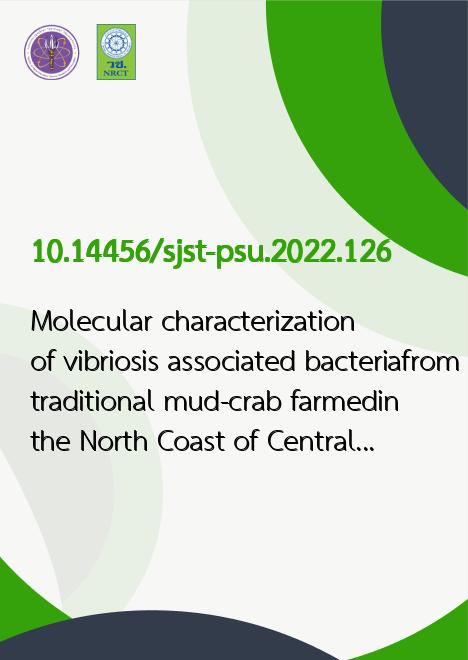
|
Molecular characterization of vibriosis associated bacteriafrom traditional mud-crab farmedin the North Coast of Central Java, Indonesia |
|---|---|
| รหัสดีโอไอ | |
| Creator | 1. Sarjito Sarjito 2. Alfabetian Harjuno Condro Haditomo 3. Slamet Budi Prayitno 4. Aninditia Sabdaningsih 5. Desrina 6. Restiana Wisnu Ariyati |
| Title | Molecular characterization of vibriosis associated bacteriafrom traditional mud-crab farmedin the North Coast of Central Java, Indonesia |
| Publisher | Research and Development Office, Prince of Songkla University |
| Publication Year | 2565 |
| Journal Title | Songklanakarin Journal of Science an Technology (SJST) |
| Journal Vol. | 44 |
| Journal No. | 4 |
| Page no. | 945-952 |
| Keyword | mud crab, 16S rRNA, rep PCR, vibriosis |
| URL Website | https://rdo.psu.ac.th/sjst/index.php |
| ISSN | 0125-3395 |
| Abstract | This study examines the molecular characterization of bacteria associated with clinical symptoms and the diversity ofvibriosis infecting farmed mud crab from three sampling locations, namely Rembang, Demak, and Kendal Districts. The clinicalsymptom was red-brown spots on carapace and wounds. Twenty-five bacterial isolates were gained from hepatopancreas, gillsand carapace of nine infected mud crabs, by culturing in TCBS and TSA medium. Molecular characterization was carried outthrough modified rep-PCR followed by 16S-rRNA gene amplification. The results indicate that seven out of the 25 isolates,namely CJR14, CJR15, CJD23, CJK10, CJK11, CJD22 and CJR05 were 92-98% firmly related to Vibrio harveyi NCIMB1280, Catenococcus thiocicly TG5-3, Photobacterium ganghwense FR311, Vibrio parahaemolyticus ATCC-1780, Shewanellaloihica PV4, Shewanella algae ATCC5, and Vibrio alginolyticus NBRC-15630. This study revealed that the 25 isolates foundfrom infected mud crabs fell into seven groups of bacteria. These seven groups were well-known as pathogens for aquaticorganisms. Moreover, according to molecular characterization, the highest diversity of Vibrionaceae was obtained fromRembang, and the bacterium most found in all three sampling sites was C. thiocicly |
